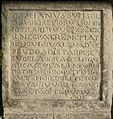Bollingen Tower
47°13′16″N 8°54′18″E / 47.2211°N 8.9051°E

Bollingen Tower is a structure built by Swiss psychiatrist Carl Jung, in appearance a small castle with several towers, located in Bollingen, on the shore of the Obersee basin of Lake Zürich, canton of St. Gallen, Switzerland.
Jung bought the estate in 1922, following the death fo his mother. He began building a primitive stone dwelling which was ultimately to develop into his Turm ("tower"). Over a twelve-year period, he added three lateral buildings to the central structure, aiming at a representation in stone of his understanding of the structure of the psyche.
In 1950, on the occasion of his 75th birthday, Jung set up a stone cube on the lakeshore, just west of the tower, inscribing it on three sides. One side contains a quote of the Rosarium philosophorum, hic lapis exilis extat, pretio quoque vilis, spernitur a stultis, amatur plus ab edoctis ("this stone is poor, and cheap in price; it is disdained by fools, but it is loved all the more by the wise"), and the dedication IN MEMORIAM NAT[ivitati]S DIEI LXXV C G JUNG EX GRAT[itudine] FEC[it] ET POS[uit] A[nn]O MCML "in memory of his 75th birthday C.G. Jung out of gratitude made and set up [this stone], in the year 1950."
On the second side, Jung Telesphorus figure, a dwarf or homunculus bearing a lantern and wearing a hooded cape, surrounded by a Greek inscription. The third side contains a Latin inscription.[1]
-
Rosarium quote and dedication
-
Greek inscription
-
Latin inscription
A second story was added after the death of Jung's wife in 1955, symbolising an "extension of consciousness achieved in old age".
For much of his life Jung spent several months a year living at Bollingen, and here he accomplished much of his writing, painting, and sculpture.
Jung's residence is now owned by a family trust and is not open to the public.
The Bollingen Foundation, founded in 1945, was named after Jung's residence.
References
- ^ Jung (1962), p. 230f. gives German translations of the inscriptions and attributes the Rosarium quote to Arnold of Villanova (d. 1311). See also Edward Armstrong Bennet, Meetings with Jung: conversations recorded during the years 1946-1961 (1985), ISBN 9783856305017, p. 31 ("Summer 1951").
- C. G. Jung, Memories, Dreams, Reflections (1962, trans. 1965), chapter "The Tower".
- Claire Dunne, Carl Jung: wounded healer of the soul : an illustrated biography, Continuum International Publishing Group (2002), ISBN 9780826463074, pp. 70f., 106-108, 139, 192 [1]



